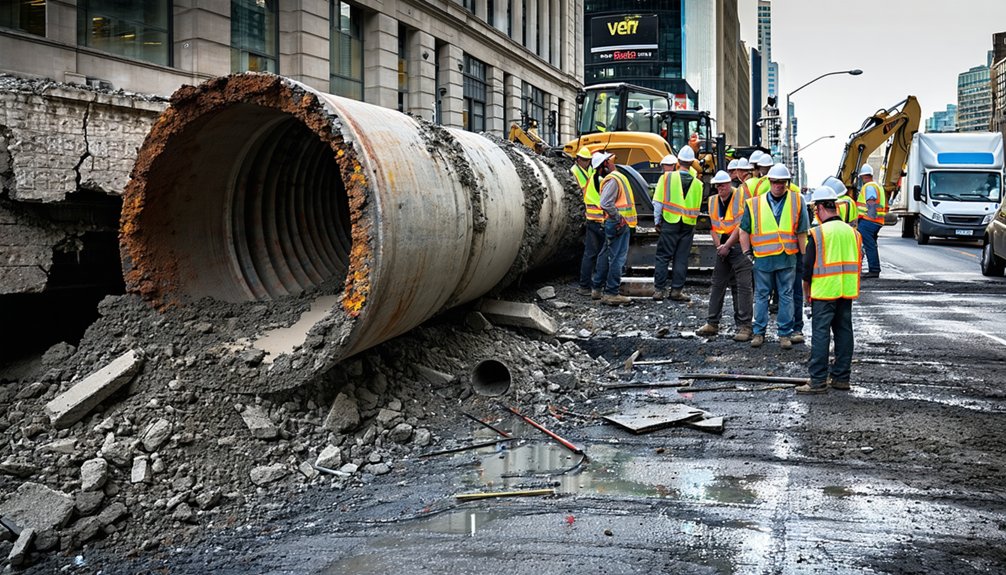Sewer line repair costs vary due to several key factors. The extent of damage plays a significant role, with minor issues costing under $1,000 and extensive damage rising to $4,000 or more. The chosen method of repair, whether traditional excavation or trenchless techniques, also influences expenses. Ultimately, the location and accessibility of the sewer lines can complicate repairs, increasing labor costs. Understanding these factors can greatly assist in anticipating potential expenses ahead.
Extent of Damage
When evaluating sewer line repair costs, the extent of damage plays a vital role in determining the overall expense. Minor issues, such as clogs or small cracks, typically incur repair costs under $1,000. In contrast, extensive damage can escalate expenses to between $2,500 and $4,000. Major breaks or collapses may necessitate a full sewer line replacement, costing between $3,000 and $7,000 depending on the severity of the damage and its location. The complexity of repairs, particularly if the damage is beneath a structure or deeply buried, can greatly increase excavation costs. Additionally, early detection of minor issues is essential, as it can prevent escalation into severe damage that requires costly repairs or replacements. Understanding the extent of damage is important for homeowners to navigate the financial implications of sewer line issues effectively.
Method of Repair or Replacement
The method chosen for sewer line repair or replacement significantly influences overall costs and project outcomes. Different approaches offer various financial implications, affecting both immediate and long-term expenses.
The method selected for sewer line repair greatly impacts costs and effectiveness, influencing both short-term and long-term financial outcomes.
- Traditional Excavation: This method typically costs between $50 to $250 per foot and involves significant labor and time, making it less efficient for extensive damage.
- Trenchless Methods: Options like pipe bursting and pipe lining may range from $60 to $250 per foot, providing a less invasive and often faster solution.
- Spot Repairs: These involve replacing 10 feet or less of pipe and can cost over 50% of a full sewer line replacement, highlighting the need for careful evaluation of the damaged sewer line.
Ultimately, each method of repair presents unique advantages, necessitating informed decisions to balance replacement costs and the repair process's effectiveness. Understanding these factors aids homeowners in choosing the most suitable solution for their sewer line repairs.
Location and Accessibility
Although various factors influence sewer line repair costs, location and accessibility often play an essential role in determining the overall expenses. The depth of the sewer can range from 12 to 72 inches underground, with deeper lines necessitating a more labor-intensive excavation process, thereby increasing costs. Accessibility challenges, such as landscaping obstacles or structures situated above the sewer line, may require extensive excavation or tunneling, additionally elevating repair expenses. In complex landscapes with limited access points, additional manpower and equipment become necessary, compounding labor costs. Moreover, the location of damage—especially if it is beneath buildings or in hard-to-reach areas—can complicate the repair process and extend timelines, impacting labor costs. Local regulations and permitting requirements vary by municipality, influencing the complexity and cost of accessing and repairing sewer lines. These factors collectively highlight the importance of location and accessibility in sewer line repair expenses.
Frequently Asked Questions
Why Is Replacing a Sewer Line so Expensive?
"Like a river running through a valley, the costs of replacing a sewer line can flow unpredictably." Factors such as sewer line materials, repair methods, and labor costs contribute considerably. Pipe diameter and depth considerations also influence expenses. Location factors, property access, and root intrusion complicate repairs further. Inspection techniques and emergency repairs may drive costs higher, ensuring that property owners face substantial financial demands when addressing sewer line issues.
Why Does Sewer Cost Change?
The variability in sewer costs is influenced by numerous factors. Key elements include sewer maintenance practices, repair techniques employed, and geographic location, which affects labor rates. Pipe materials also greatly impact costs, as different types offer varying durability. Additionally, inspection methods and damage assessments play an essential role in determining repair needs. Seasonal impacts and advancements in technology further contribute to cost fluctuations, creating a complex landscape for sewer repair expenses.
Are Local Governments Responsible for Paying for Sewer Line Repairs?
In the intricate dance of public infrastructure, local governments typically do not wade into the waters of sewer maintenance on private property. Homeowner obligations rise like a tide, leaving individuals responsible for repair responsibilities that stretch from their homes to the main sewer lines. Although funding sources and emergency repairs may find support in some areas, policy implications vary, shaping community impact and budget allocations uniquely across municipalities.
How Often Do Sewer Lines Need to Be Replaced?
Sewer lines typically require replacement every 40 to 60 years, influenced by factors such as sewer line lifespan, soil composition, and environmental conditions. Common replacement reasons include aging infrastructure, signs of malfunctioning like frequent clogs and sewage backups, and tree root intrusion. Maintenance frequency and plumbing inspections can extend longevity, but neglect may accelerate deterioration. Replacement materials also impact durability, necessitating vigilance in monitoring sewer line health to prevent costly repairs.



